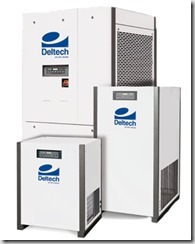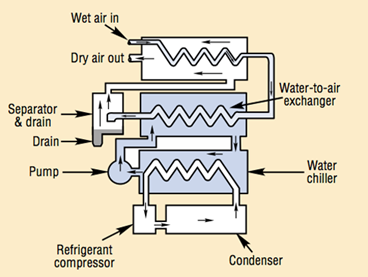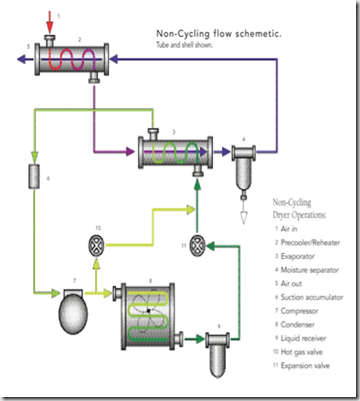Last week we covered Compressed Air Dryer – 101 which gave an overview of why air dryers are needed and how water enters the compressed air system.
Today we review the most common category of compressed air dryer, the refrigerated air dryer.
While the refrigerated dryer is by far the most widely used category of compressed air dryer, it does not offer as low a dew point as can be attained with other categories. The big selling feature for the refrigerated dryer is the the low initial investment in conjunction with a usually acceptable dew point for a wide range of industrial applications.
The principle of operation is much like a typical home refrigerator or residential air conditioner system. The compressed air is cooled in an air-to-refrigerant heat exchanger down to about 350F. The moisture is condensed to a liquid state where it is removed by an internal separator and then drained from the unit with an automatic drain. The compressed air is then reheated in an air-to-air heat exchanger where the incoming compressed air first passes. This also pre-cools the incoming compressed air thus reducing the load on the refrigeration system.
This flow path allows the compressed air to exit the dryer with a pressure dew point of 350 to 400F. A lower dew point is not feasible with a refrigerated dryer as the condensate would freeze at 320F or lower.
The advantages of refrigerant type dryers include:
- Low, initial capital investment
- Low operating cost
- Low maintenance cost
- No damage caused by oil in the air stream (*filtration is still typically recommended)
Disadvantages of refrigerant type dryers include:
- Limited dew point suppression
There are a few different types of dryers in the refrigerated classification.
The first being the non-cycling type. In a non-cycling type refrigerated dryer, the refrigerant circulates continuously through the system. This design provides quick response to changes in operating loads (flow rates, ambient temperatures & pressures). Since the flow of compressed air will continuously vary and ambient temperatures also vary, a hot gas bypass valve or unloader valve is often used to regulate the flow of the refrigerant and maintain stable operating conditions within the refrigerant system. In most designs, the refrigerant evaporates within the air-to-refrigerant heat exchanger and is condensed after compression by an air or water-to-refrigerant heat exchanger.
The schematic below offers an overview of the system flows.
While older types of refrigerated dryers have utilized CFC refrigerants such as R12 and/or R22, todays newer designs have moved to incorporate chlorine free refrigerants such as R134, R407 or other environmentally friendly refrigerants making this a non-issue for todays industrial plants. However, the use of the new refrigerant types do require careful attention to the refrigerant system designs due to differences in operating pressures and temperatures. These and all refrigerated type air dryers should be serviced only by a licensed and trained technician to assure compliance with refrigerant recovery and release regulations.
Advantages of non-cycling refrigerated dryers include:
- Minimal dew point fluctuation
- Refrigerant compressor operates continuously
Disadvantages of non-cycling refrigerated dryers include:
- No energy savings at part load and/or no flow conditions
The next type of refrigerated air dryer is termed a “cycling type dryer” which use the refrigerant to chill a mass of material surrounding the compressed air passages in the heat exchanger. The mass may be a liquid such as glycol or metal such as aluminum block, beads or other type of material, which act as a heat sink. The compressed air is cooled by the heat sink which has its temperature controlled by a thermostat and shuts off the refrigerant compressor during reduced loads, providing savings in operating cost. The detriment to the cycling type dryer is the higher initial investment.
Advantages of cycling type refrigerated dryers include:
- Energy savings at part load and/or no flow condition
Disadvantages of cycling type refrigerated dryers include:
- Dew Point fluctuation
- Increased size and weight to accommodate the heat sink mass
- Higher initial investment
The final type of refrigerated dryer I wanted to discuss is relatively new on the scene and what I call a load matching dryer. This dryer utilizes a digital scroll type type compressor which is capable of unloading. Thereby offering reduced energy consumption by matching the refrigeration requirement to the flow rate of the moment in conjunction with the ambient temperature. A tremendous feature of these units is they are modular so the modules can be connected to create the size of system required. The modules for this particular type of dryer come in 2 sizes, 1250 SCFM and 2500 SCFM. Each module can be completely isolated for maintenance. Systems can be built from 1250 SCFM up to 12,500 SCFM. It is important to note that standard cycling type or thermal mass refrigerated dryers are also available in modular forms but do not offer the digital scroll (unloading type) refrigeration compressors.
Advantages of load matching type refrigerated dryers include:
- Pressure dew point stability from 0% to 100% load
- Instantaneous response to load changes
- No dew point spikes
Disadvantages of load matching type refrigerated dryers include:
- Small sizes are not available
- Higher initial investment (comparable to non-cycling type)







It is helpful to know about the dew point fluctuation, as well as all of the other characteristics of this type of refrigerated dryer. Do you happen to know what kind of maintenance this would require? I want to avoid having a problem, but I am not sure that I want to commit to a very complicated routine. Thank you for all of the applicable information!
Hello Brooke
Thanks for your comment. You are correct that dew point fluctuation can be a concern depending on the end use of the compressed air. A high quality dew point monitor added to the system could actuate an alarm based on an excessive rise in dew point. A simple fix with no complicated routine required.